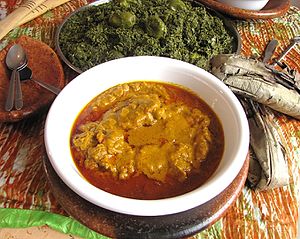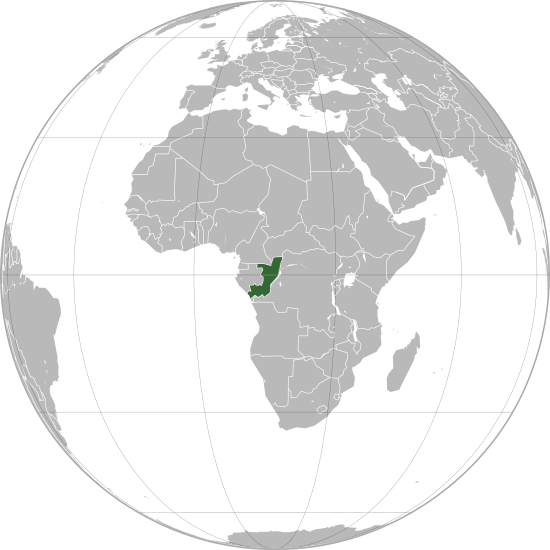Culture of the Republic of the Congo
Script error: No such module "Draft topics". Script error: No such module "AfC topic".

The culture of the Republic of the Congo[2] features a diverse culture characterized by it's numerous ethnic groups, history, music, cusine, and traditions. This country was established in 1958 and has been independent since 1960. The Republic of Congo is located between Gabon and the Democratic Republic of Congo and the capital is Brazzaville. Christianity and colonialism had a great impact on the culture and and artistic expression of this country. Music and dance of the Republic of Congo were greatly impacted by western instruments and musical styles and continue to remain popular today.
Language and religious culture[edit]
Dialect[edit]
The main language spoken and official language of the Republic of Congo is the French language, spoken by roughly 50% of the country, however a large majority of the population is billingual. The other languages spoken are Bantu languages, Lingala, and Kituba. According to Laval University, the civil wars that rocked this country are the main reason that French is the official language, as many speak French instead of their native language in fear of revealing their ethnicity. Kituba is a Kikongo based creole that is only understandable to users of dialects of Kikongo. 50% of the country speaks this language, and is most commonly spoken in locations near the Congo Ocean railway line. Lingala, known as the river language, is spoken primarily in the north and east of the Republic of Congo. This language is spoken by the president of the country, Denis Sassou-Nguesso and is growing quickly.
Religion[edit]
Three fourths of the population is Christian. The primary religion in the Republic of Congo is Roman Catholic, practiced by 33.1% of the population. 22.3% of the population practices Christian Revival, 19.9% of the populations practices Protestant[3], which also includes the Evangelical Church of the Congo. 11.3% of the population practices no religion. Salutiste, Muslim, and other tribal religions make up the remaining 13.4% of the population.
History[edit]
The Republic of Congo, also known as Middle-Congo and Congo, was formerly a French colony. After independence in 1960, the French region Congo became the Republic of Congo, not to be confused with the Democratic Republic of Congo. Marxism was prevalent in this country following independence, until 1990 when Marxism was abandoned and a democratic government was adopted. A civil war occurred in 1997 that brought former Marxist president Denis Sassou-Nguesso back into power.
Music[edit]

Rumba and soukous are popular music genres in the Republic of Congo, grown from kwassa kwassa dance rhythm's. The Republic of Congo is known for popularizing rumba music. Music selection is similar to that of the Democratic Republic of Congo due to the Congo crisis.
Rumba[edit]
Congolese Rumba originated in the Congo basin during the 1940's, and derived from the genre of music called Cuban son. Rumba gained popularity throughout Africa during the 1970's and continues to remain relevant today.
Soukous[edit]
Soukous is dance music that derived from Congolese Rumba. This dance music features fast dance rhythms along with guitar improvisation. Soukous gained popularity in France in the 1980's and remains popular throughout Africa.
Cuisine[edit]
Maize, rice, cassava, sweet potatoes, and yam's are the main foods eaten in the Republic of Congo. The most commonly eaten food is cassava and the national drink of the Republic of Congo is Lotoko
Popular dishes[edit]

- Poulet à la Moambe is the national dish of Congo, the dish is a chicken stew prepared with simmered chicken, palm butter, and spices. This meal is very popular and is also the national dish of Gabon and Angola.
- Fufu is popular throughout Africa, but especially in the central and western provinces. fufu is a dough porridge that is formed into balls and ease with soup or stew.
- Fumbwa is a spinach stew. The recipe includes boiling spinach, tomatoes, and onions. Sometimes catfish is added for flavor and the dish is commonly eaten with fufu
- Ntaba is a popular street food that consists of grilled pork or goat meat.
- Kwanga is fermented break prepared from cassava and wrapped in nana leaves. The dish is sticky and tasteless and is often eaten with soup or stew.
- Dabo Kolo is a popular finger food in the Republic of Congo consisting of baked brea in small cubes. The food is often eaten during festivals.
Art, sports, and tradition[edit]

Traditions in the Republic of Congo include sculpture and masks. There are 7 national holidays, and the time spent celebrating each holiday is announced by the ministry of labor at the end of each year. The main sports played are soccer, basketball, handball, and volleyball.
Artwork[edit]
Traditional Congolese art is varied depending on what region of the country it originates from[4]. Artwork is composed of Songye, Tshokwe, Kuba, and Pende arts, which each represent different regions and ethnicities of the country. Art forms in the Republic of Congo include ceramics, tapestry, weaving, and sculpture. Traditional Congolese art is characterized by its naturalism, realism, and rich colors, often in the form of masks and sculptures.
Sports and recreation[edit]
Soccer is the most popular sport in the Republic of Congo, and their national team is nicknamed "The Red Devils"[5] . This team won their first African Cup of Nations in the early 70's. Some notable soccer players from the Republic of Congo include Sita Milandou, who plays for the Omani Giants, and Mael Lepicier, who plays for the team Mons. Other popular sports include handball and volleyball. Basketball and tennis are quickly gaining popularity due to the success of Congolese athletes such as Serge Ibaka, who plays for the NBA team Milwaukee Bucks, and Jo-Wilfried Tsonga, a tennis player who made it to the semi-finals at Wimbledon in 2011 and 2012.
Customs and traditions[edit]
Popular traditions in the Republic of Congo include Moziki, and "La Presentation". Moziki refers to a group of people that gather with the goal of helping each other financially for large events such as birthdays, weddings, and funerals. Moziki often involves celebration after the goal has been completed. "La presentation" is a presentation that a man performs for his girlfriend's parents to show respect. The presentation is in the form of a ceremony and the man is expected to bring gifts and ask for permission to date the daughter of the parents.
Holidays[edit]
- New Year's Day
- Labour Day
- Reconciliation Day
- National Day
- All Saints' Day
- Republic Day
- Christmas Day
References[edit]
- ↑ Press, World Trade. Congo, Dem. Rep. of Society & Culture Complete Report : An All-Inclusive Profile Combining All of Our Society and Culture Reports. 2nd ed., World Trade Press, 2010.
- ↑ Mukenge, Tshilemalema. Culture and Customs of the Congo. Greenwood Press, 2002.
- ↑ Maryks, Robert Aleksander ; Festo Mkenda, S.J ; Festo Mkenda ; Robert Aleksander Maryks. Encounters Between Jesuits and Protestants in Africa. BRILL, 2017, https://doi.org/10.1163/j.ctvbqs62t.
- ↑ Democratic Rep. of Congo Society & Culture. 2nd ed., World Trade Press, 1993.
- ↑ Gelindo, Lukemba. Son of a Red Devil. African Books Collective, 2012.
- ↑ Van Beurden, Sarah. “THE ART OF (RE)POSSESSION: HERITAGE AND THE CULTURAL POLITICS OF CONGO’S DECOLONIZATION.” The Journal of African History, vol. 56, no. 1, 2015, pp. 143–64. JSTOR, http://www.jstor.org/stable/43305243. Accessed 4 Dec. 2022. Copy
- ↑ VAN BEURDEN, SARAH. “THE ART OF (RE)POSSESSION: HERITAGE AND THE CULTURAL POLITICS OF CONGO'S DECOLONIZATION.” The Journal of African History, vol. 56, no. 1, 2015, pp. 143–164., doi:10.1017/S0021853714000681.
- ↑ “Congolese Culture.” Friends of the Congo, https://friendsofthecongo.org/congolese-culture/. Accessed 4 Dec. 2022.
- ↑ Republic of the Congo - Cultural Life | Britannica. https://www.britannica.com/place/Republic-of-the-Congo/Cultural-life. Accessed 2 Dec. 2022.
This article "Culture of the Republic of the Congo" is from Wikipedia. The list of its authors can be seen in its historical and/or the page Edithistory:Culture of the Republic of the Congo. Articles copied from Draft Namespace on Wikipedia could be seen on the Draft Namespace of Wikipedia and not main one.

|
This page exists already on Wikipedia. |

